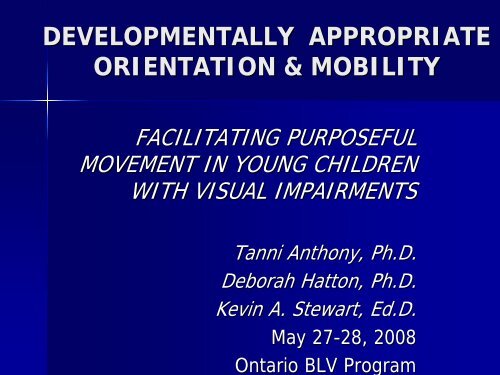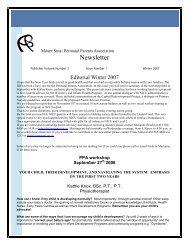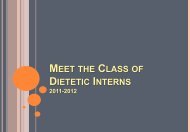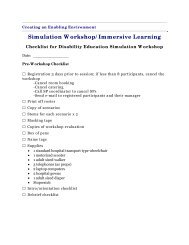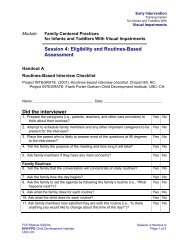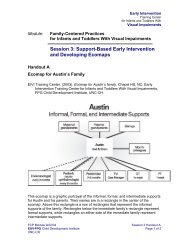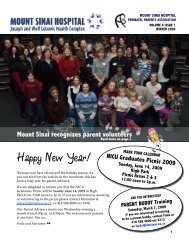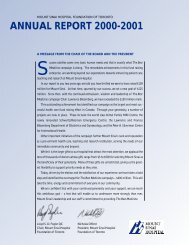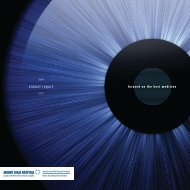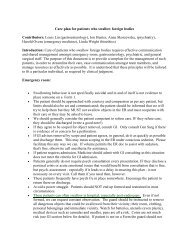Developmentally Appropriate Orientation and Mobility - Mount Sinai ...
Developmentally Appropriate Orientation and Mobility - Mount Sinai ...
Developmentally Appropriate Orientation and Mobility - Mount Sinai ...
- No tags were found...
You also want an ePaper? Increase the reach of your titles
YUMPU automatically turns print PDFs into web optimized ePapers that Google loves.
DEVELOPMENTALLY APPROPRIATEORIENTATION & MOBILITYFACILITATING PURPOSEFULMOVEMENT IN YOUNG CHILDRENWITH VISUAL IMPAIRMENTSTanni Anthony, Ph.D.Deborah Hatton, Ph.D.Kevin A. Stewart, Ed.D.May 27-28, 28, 2008Ontario BLV Program
Learning Objectives• Define orientation <strong>and</strong> mobility <strong>and</strong> describethe developmental approach as it applies toyoung children who are blind/low vision,with <strong>and</strong> without additional disabilities.• Describe the components of early /developmentally appropriate orientation <strong>and</strong>mobility.
Learning Objectives• Describe the potential impact of blindness/low vision on motor development <strong>and</strong>movement needed for orientation &mobility; <strong>and</strong> strategies for promoting thedevelopment of these skills using naturallearning opportunities.
“Children with visual impairment learndifferently, for no other reason thanthe fact that in most cases they cannotrely on their vision to provideinformation. The information theyobtain through their other senses isinconsistent, fragmented, , <strong>and</strong> passive.It takes practise, training, <strong>and</strong> time tosort all this out.”(Ferrell, 1997)
“Just think about how much childrenlearn by looking <strong>and</strong> throughobserving what is happening aroundthem. With reduced or absence ofvisual information children withsignificant visual loss are at risk inearly learning <strong>and</strong> development.”(Chen, 2002)
DEVELOPMENTALLY APPROPRIATEORIENTATION & MOBILITY
O&M for Young Children• <strong>Orientation</strong> can be defined as “knowing oneself as aseparate being, where one is in space, where onewants to move in space, <strong>and</strong> how to get to that place”(Anthony, 1993, p. 116).• “<strong>Mobility</strong>refers to motor development, including thenormal integration of reflexes, acquisition of motormilestones, refinement of quality-ofof-movement skills,<strong>and</strong> purposeful, self-initiated movement” (Anthony etal., 2002, p.328).
PurposeTo assist infants, toddlers <strong>and</strong> preschoolchildren ( (including children with multipledisabilities) in developing their sensory <strong>and</strong>environmental awareness to facilitatepurposeful <strong>and</strong> self-initiated movementpatterns through daily routines <strong>and</strong> playactivities.(Stewart, 2006)
Developmental O&M
Components of Early O&MDevelopmental O&M programs for young childrenshould include the following components:• sensory skill development,• concept development, <strong>and</strong>• motor development (including purposeful<strong>and</strong> self-initiated movement).Additional components for preschoolers include• environment <strong>and</strong> community awareness <strong>and</strong>• formal orientation <strong>and</strong> mobility skills.Anthony et al., 2002 ; Dodson-Burk & Rosen, 2002 ; Hill, RosenCorrea, & Langley, 1984
Components of Early O&M• <strong>Orientation</strong>—to to exp<strong>and</strong> children’s s body concepts,daily settings, <strong>and</strong> locations within each environment• <strong>Mobility</strong>—to to encourage <strong>and</strong> refine independentmovement (including the use of mobility devices)• Purposeful Movement—to to reinforce children’sreasons to move in different environments• Environmental analysis for safety—to to assistthe family <strong>and</strong> transdisciplinary team in analyzingnatural environments, to ensure self-initiated <strong>and</strong>purposeful movement(Anthony , Bleier, Fazzi, , Kish, & Pogrund, , 2002)
Analyze <strong>and</strong> build an environmentthat is supportive of sensorylearning.
Let’s Get Learning- Attachment- Concepts- Object Permanence- Cause/Effect- Means-endend- Imitation
What is learning?• Learning depends on cognition:Cognition is thought• Progresses beyond perception• Involves attachment, attention, body,object & space, communication /language• Developmental continuum
Cognitive development drivespurposeful movementChildren with severe visual impairments donot locomote—move move purposefully <strong>and</strong>independently—until they acquire the objectconcept, the underst<strong>and</strong>ing that objects existeven though they may not be directlyperceived. (This is fair.)Bigelow, 1986, 1990, 1992; Fraiberg, 1977;Rogers & Puchalski, , 1988; Trösterster & Brambring, , 1993;Warren & Hatton, 2003
Attachment <strong>and</strong> <strong>Mobility</strong>• Secure attachment is believed to be relatedto the willingness of infants to venture outinto the environments to explore <strong>and</strong>experience it.• Infants’ early social-emotional responseselicit <strong>and</strong> maintain proximity <strong>and</strong>interactions with other people for protection<strong>and</strong> survival, <strong>and</strong> facilitate development inall domains.
Attachment <strong>and</strong> <strong>Mobility</strong>• Social referencing provides children with theself-confidence to move <strong>and</strong> explore.• Severe visual impairments may impedeexploration <strong>and</strong> movement– by making attachment more challenging,– by possibly decreasing motivation to move outinto the world to explore it, <strong>and</strong>– by making it difficult or impossible to glace backat the caregiver (social referencing) during earlyexploration.(Warren & Hatten, , 2003)
ConceptsConcepts are mental representations ofimages <strong>and</strong> ideas <strong>and</strong>, for orientation <strong>and</strong>mobility, can be categorized as• body concepts,• object concepts,• environmental concepts, <strong>and</strong>• spatial <strong>and</strong> positional concepts.Long & Hill, 1997Skellenger <strong>Orientation</strong> & Hill, & <strong>Mobility</strong> 19973J
Concept Levels• Concrete—knowledge of specificcharacteristics• Functional—underst<strong>and</strong>ing underst<strong>and</strong>ing purpose orfunction• Abstract—underst<strong>and</strong>ing of characteristics <strong>and</strong>purposes <strong>and</strong> ability to generalize to otheruses <strong>and</strong> situationsSkellenger & Hill, 1997
Body Concept / Image• Body concept describes theability to perceive <strong>and</strong>underst<strong>and</strong> the positions orpotential positions of one’sbody.• Children with some usefulvision <strong>and</strong> with highercognitive abilities tend toLong & Hill, 1997have better body concepts.
Anthony, Bleier, Fazzi, Kish, & Pogrund, 2002Development of BodyConcepts• Awareness of touch, posture, <strong>and</strong> body movement(i.e., mapping of the immediate body)• Awareness of body parts through movement• Identification of body parts• Identification of body planes• Underst<strong>and</strong>ing relationship of body parts <strong>and</strong>planes to movement• Identification of self in relation to objects <strong>and</strong> space• Laterality of self <strong>and</strong> objects
Facilitating Body Image inInfants <strong>and</strong> Toddlers With VI• Provide consistentnurturing, responsivecare with appropriatesensory cues• Encourage infantmassage• Play interactive, turn-taking games involvingwhole bodymovements• Play body movement<strong>and</strong> naming gamesduring daily routines• Provide sensoryexperiences that helpchildren become moreaware of their bodyparts <strong>and</strong> relationshipsamong body parts• Encourage purposefulmovement whilenaming body partsbeing moved.
Object Concepts• Object concept refers to underst<strong>and</strong>ing what anobject is <strong>and</strong>, later, its function <strong>and</strong> meaning.• Through repeated <strong>and</strong> meaningful experiences withobjects such as bottles, rattles, <strong>and</strong> rubber squeaktoys, infants begin to recognize the sensory featuresof objects.• Objects used in daily routines <strong>and</strong> natural learningopportunities help children to anticipate<strong>and</strong> participate in daily routines.
Object Permanence• The underst<strong>and</strong>ing that an object continuesto exist even if it is not providing currentsensory stimulation. (Warren, 1994)• Sighted infants develop this skill around 9months.
Strategies for PromotingObject Permanence• Recognize signalsthat convey interestin items recentlyremoved fromtouch.• Provide tactile <strong>and</strong>,later sound cues toencouragereaching.• Provide organized<strong>and</strong> consistent playspaces.• Involve children inthe retrieval ofdesired objects.
The child learns that objectshave permanence.When interacting with the child, try to:• Let the child be an active participant inacquiring objects from their specific location• Let the child be an active participant inreturning objects to their specific location• Return to the location of a favorite ornecessary object frequently
Use of TraysMetal cake pan or wooden trayCardboard box top coveredwith contact paper <strong>and</strong> heldon with a clamp
Object SchemesDeliberate actions that involve objects arecalled object schemes. Examples of objectschemes include• bringing a ring to mouth,• playing with paper,• banging objects,• putting on a shoe, <strong>and</strong>• peeling a banana.
Object Constancy• Ability to perceive an object as unchangingeven under different conditions ofobservation.• Children acquire object constancy throughmultiple, h<strong>and</strong>s-on experiences with objects.
Comparative Learning• Different objectsrequire differentactions.• Objects in the samecategory may havedifferent characteristics.• Objects have different sizes, shapes, textures,etc.Anthony et al., 2002
Objects differ from one another.When interacting with the child, try to:• Provide the child with enough time tomanipulate the objects.• Encourage the child to compare twoobjects.• Start with objects which vary greatly<strong>and</strong> move to more similar objects.• Point out similarities <strong>and</strong> differencesbetween two objects.
Cause <strong>and</strong> Effect• Children learn that they can make thingshappen <strong>and</strong> control the environment.• Use h<strong>and</strong>s to reach for items <strong>and</strong> to makethings happen.• Bounce up <strong>and</strong> down to signal “more”• Vocalize or gesture to secure “more” of afavourite food or activity.
Strategies to FacilitateCause <strong>and</strong> Effect• Arrange environment to entice movement tolocate desired objects.• Encourage use of gesturesor vocalizations beforethey receive “more”• Provide activities thatprovide sensory feedback from movement.
Means-End RelationshipsWhen children problem solve to identify amethod for securing a desired object oraccomplish a task.– Wiggling body to move closer to object– Reaching with mouth when holding object– Pulling blanket so that the toy moves closer– Unwrapping a snack– Opening a container to obtain an object
Imitation• Children with visual impairments may nothave the benefit of observing others <strong>and</strong>may not be able to acquire as manyconcepts through imitation.• Need assistance in developing concepts <strong>and</strong>motor skills that sighted children acquirethrough observation <strong>and</strong> imitation.– Rolling a ball back <strong>and</strong> forth– Pedaling a tricycle– Putting shapes in a form board
Environmental ConceptsAllow children to explore environments in asystematic manner without intruding.– Provide simple descriptions– Identify l<strong>and</strong>marks– Identify sensory features of areas– Keep furniture <strong>and</strong> toys in predictable positions– Task-analyze analyze daily events <strong>and</strong> have childparticipate as independently as possible.– Repeat experiences often
EnvironmentalConcepts
Development of SpatialConcepts• Mapping of body-toto-object object relationships• Mapping of size <strong>and</strong> shape relationships• Mapping of part-toto-whole relationships• Mapping of temporal space• Mapping of distant space
Strategies for Young Childrenwith Additional DisabilitiesStrategies that may facilitate cognitivedevelopment:– Engaging materials,– Repetition,– Consistency/routines,– Guided <strong>and</strong> independent experiences, <strong>and</strong>– Immediate positive reinforcement.
“Let’s Get Moving”- Developmental Principle- Challenges & Strategies
The Process of MotorDevelopment• Directionality– Cephalo-caudal:Infants’ musculardevelopment proceeds from head to toe.– Proximo-distal:Infants improve control ofmuscles starting at the midline of the body<strong>and</strong> moving toward extremities.– Gross to fine: Infants gain control overtheir larger muscles before their smallermuscles.Alex<strong>and</strong>er, Boehme, , & Cupps, , 1993
The Process of MotorDevelopment• Sequence: With each developmental step,the next skill missed or not fully masteredwill affect children’s s abilities to achievesubsequent skill mastery.• <strong>Mobility</strong> <strong>and</strong> Stability: The acquisition ofcontrolled movement or of postural controlrequires both stability (maintaining aposture) <strong>and</strong> mobility.Alex<strong>and</strong>er et al., 1993Gilfoyle, , Grady, & Moore, 1981
The Process of MotorDevelopmentSensation: Sensoryinformation is used tomotivate <strong>and</strong> direct allmotor behaviors.
Four Variables InfluencingMotor DevelopmentVariables that affect the rate <strong>and</strong>quality of motor development of youngchildren include• healthy brain maturation,• healthy central nervous system,• unaffected input from sensory systems, <strong>and</strong>• opportunities to practice skills.Allen & Marotz, , 1994
Early Reflexes• Involuntary responses to specific sensoryinput.• Newborns’ reflexive behaviours dominatemovement.• Become integrated into voluntary motorresponses within the first year.
Postural ReactionsAutomatic movements <strong>and</strong> adjustments inresponse to, or in anticipation of, changesof position in relation to the center ofgravity.– Righting reactions– Protective <strong>and</strong> supportive reactions– Equilibrium (Balance)(Brown, 1988)
Postural Tone• Postural tone refersto the readiness of themuscles to respond tostimuli from the brain.• Postural tone can betoo high (hypertonia(hypertonia),too low (hypotonia(hypotonia),or fluctuating betweenhigh <strong>and</strong> low (athetoid(athetoid).
Postural Tone• Children who have motor dysfunction canpresent with abnormal postural tone.• Postural tone is changeable <strong>and</strong> can beinfluenced by movement, h<strong>and</strong>ling,positioning, or the task itself.
Postural Stability• Stability refers to the ability to maintainbody posture as weight is shifted.• Young children may use certain positionsthat provide mechanical stability toperform a new movement (e.g., widebase of support).Alex<strong>and</strong>er et al., 1993
Postural Stability• Another method infants may use to providestability is to fix or hold parts of the bodythrough muscle contraction.• Through maturation <strong>and</strong> the practice ofmovement, the muscles will be capable ofproviding dynamic stability.Alex<strong>and</strong>er et al., 1993
BVI <strong>and</strong> Postural Development• Research results suggest that motor developmentis delayed <strong>and</strong> that infants who are blind/visuallyimpaired often have atypical patterns of motordevelopment.• The impact of visual impairment on early motordevelopment depends on a complex set ofinteractions between children’s s characteristics <strong>and</strong>the characteristics of the social <strong>and</strong> physicalenvironment.Adelson & Fraiberg, , 1974; Ross & Tobin, 1997;Sonksen, Levitt, , & Kitsinger, , 1984; Warren, 1994
Child Characteristics ThatImpact Postural Control• Multiple disabilities• Prematurity• Amount of functional visionWarren, 1994
Influences of BVIon Postural ControlChildren who are blind/visually impaired may display• low postural tone;• decrease in head-righting responses tomovement;• lack of head <strong>and</strong> trunk rotation;• delays in the development of protective,righting, <strong>and</strong> equilibrium reactions; <strong>and</strong>• paucity of movement <strong>and</strong> decreased explorationof the environment.Adelson & Fraiberg, , 1974; Brown & Bour, , 1987; Hart, 1984;Prechtl et al., 2001; Sonksen et al., 1984; Tröster& Brambring, , 1993
Goal-Directed MovementCaregivers <strong>and</strong> earlyinterventionists shouldencourage goal-directedmovement, which involvespurposeful <strong>and</strong> self-initiatedmovement.Anthony, 1993
Transitional MovementAlthough children who are blindmay be able to sit <strong>and</strong> st<strong>and</strong>independently within the agerange of sighted children, theymay not move into, out of, orforward from these positionsat the same ages as sightedchildren. Adelson & Fraiberg, 1974
Crawling• Some children who are blind/visually impaireddemonstrate delays in crawling; othersnever crawl.• Developmental lags in crawling might berelated to the fact that reaching to objectsby sound alone occurs later in infantswho are blind.Adelson & Fraiberg, , 1974Fraiberg, , 1977Trösteret al., 1994
Strategies toEncourage CrawlingProvide opportunities to• reach while in the prone position <strong>and</strong>on all fours, <strong>and</strong> to• play on all fours, especially toencourage side-toto-side weight shifts todevelop the balance needed to shiftweight <strong>and</strong> free one side for movement.
Strategies toEncourage CrawlingFacilitate movementtransitions from sittingto all fours, as well asearlier transitions(prone to supine,supine to sit) to develop theunderlying components ofmovement needed for crawling.
Strategies toEncourage Crawling• Provide opportunities for childrento increase underst<strong>and</strong>ing of objectpermanence.• Use sensory informationto become familiar<strong>and</strong> to motivate themto move purposefullyin space.
Defined SpacesThe use of definedspaces with meaningfulobjects in predictablepositions can exp<strong>and</strong>children’s s underst<strong>and</strong>ingof the environment <strong>and</strong>promote independence.
Defined Spaces• Defined spaces are areas in whichmeaningful objects are kept inpredictable positions.• Defined spaces can be used across acontinuum of activities in a wide rangeof locations.• Highchair trays <strong>and</strong> cribs can serve asdefined spaces to encourage reaching
Creating Defined Spaces• The size of the area should be establishedinitially, <strong>and</strong> increased very gradually.• Heavy furniture, walls, or cabinets shouldborder at least two sides.• Toys <strong>and</strong> objects in the play space shouldbe highly meaningful <strong>and</strong> motivating.• These toys <strong>and</strong> objects should be kept inpredictable positions.
Fine Motor Skills• Fine motor skills include discreteh<strong>and</strong> skills, or prehension.• Awareness of h<strong>and</strong>s <strong>and</strong> theunderst<strong>and</strong>ing that h<strong>and</strong>s canbe used purposefully is an earlyfine motor milestone.
Strategies to PromoteEffective Use of the H<strong>and</strong>s• Helping infants findtheir h<strong>and</strong>s• Facilitating h<strong>and</strong>-toto-h<strong>and</strong>play in midline• Facilitating thedevelopment of grasp• Providing multiple <strong>and</strong> variedopportunities for grasping
Strategies to PromoteEffective Use of the H<strong>and</strong>s• Provide firm proprioceptive input intothe h<strong>and</strong>s.• Promote h<strong>and</strong>-to-h<strong>and</strong>play, h<strong>and</strong>-to-mouth play,<strong>and</strong> h<strong>and</strong>-to-foot play tofacilitate an awarenessof the h<strong>and</strong>s <strong>and</strong> midlineorientation of the body.
“ It is not important to look at the ageat which a child achieves certainmilestones as it is to assess how thechild’s development is proceeding <strong>and</strong> thequality of that development.”(Nagaishi,, 1993)
Summary of Strategies• Active Participants• Experiencemovements• Positions• “Tummy” play• Movements• Interpret senses• Safe space• Encourageindependence• Positioning• Use of h<strong>and</strong>s
Most ImportantEnjoy the successes, learn from themistakes, <strong>and</strong> have fun in theexperience of “ “Learning with yourChild”.(Anthony, 1993)


